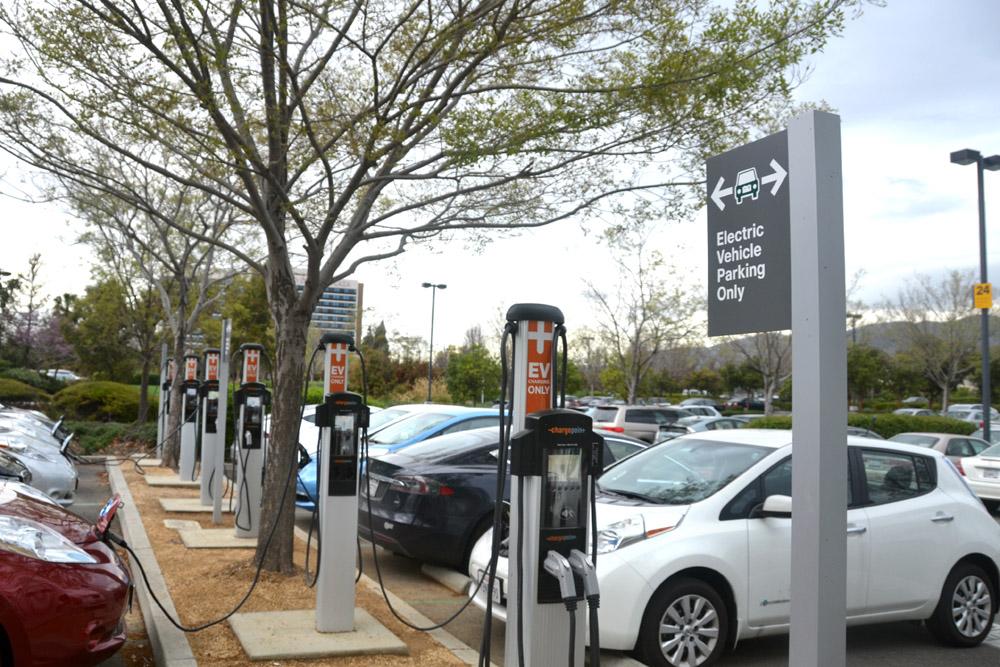From Refill to Recharge: How Electric Vehicles are Changing City Infrastructure
by Emma Kantrowitz
CBRE Blueprint | Play of the Land
The phrase, “I have to stop for gas,” might be on its way out.
Talk of electric vehicle proliferation has been occurring for years across the U.S. and around the globe, but the future of the auto industry is no longer merely on the horizon. Given the recent announcements from major car manufacturers planning to reduce the number of gasoline-fueled models and increase the amount of electric vehicle options, it seems that the industry’s future has arrived.
According to the recent From Gas to Grid report from the Rocky Mountain Institute (RMI), an independent nonprofit seeking to transform global energy use, the gatekeepers to the rise of electric vehicles are high purchase price, limited models, low mileage range and public charging infrastructure scarcity. But according to the recent announcements, some of those factors are being addressed: Ford will add 13 electric models to its lineup over the next several years, investing $4.5 billion in the process; Volkswagen plans to introduce more than 30 electric vehicles over the coming decade; every car Volvo launches starting in 2019 will be electric; BMW expects electric vehicles to account for 15 to 25 percent of total sales by 2025; Porsche CEO Oliver Blume says that by 2023, he expects half the company’s production to be electric vehicles.
With dozens more electric vehicle models to choose from, improved range and decreasing purchase price (after tax credits, there are now 15 models of electric vehicles available from major manufacturers under $30,000, according to the RMI report, and those prices will only continue to decrease as technology advances), only one road block remains: public charging infrastructure.
Companies like ChargePoint, a designer and developer of electric vehicle charging hardware and software, are leading the way as municipalities continue to figure out how to seamlessly incorporate charging stations into built-up city infrastructure.
“The charging infrastructure to support the electric vehicle adoption rise is already in place and growing every day,” says Darryll Harrison, ChargePoint’s director of global communications. “Though often seamless to the average person because charging, unlike refueling, happens as part of our work, home and on-the-go lives, ChargePoint alone has more than 41,000 charging spots, supporting every electric vehicle available on the market today.”
While those 41,000 charging locations were created by ChargePoint, their model is such that each charging station is purchased by a consumer (an individual for home use, a retailer for parking lot use, a company for employee use, etc.) and owned individually.
“By installing charging spots, retail destinations attract new customers and build a steady revenue stream from repeat buyers with higher spending capacity, while leading employers attract and retain talent by offering workplace charging as a benefit,” Harrison notes.
Interestingly, though the top three places ChargePoint services—Los Angeles, California’s Bay Area and the New York, New Jersey, Connecticut area—might seem obvious for electric vehicle ownership, ChargePoint’s cities with the most growth are less so. Las Vegas, Kansas City, Raleigh/Durham and Denver are all on the rise.
As the numbers increase across the board (electric vehicle sales are up 45 percent from July 2016 to July 2017), charging stations will become all the more important. And considering the potential ban on the sale of new gasoline and diesel vehicles, gas stations might eventually become a thing of the past. In the U.S., California Gov. Jerry Brown issued an executive order that will help get 1.5 million zero-emission vehicles on the road by 2025. But around the globe, countries are taking it a step further.
France and the U.K. will ban the sale of any new gasoline and diesel vehicles by 2040. Norway’s proposed ban will go into effect by 2025. India plans to sell only electric vehicles by 2030. Even China, where roughly 28 million vehicles were sold last year and only one percent of them was electric, is working on a ban of their own.
Harrison adds: “We believe cities around the world are part of a ‘perfect storm’ driving significant electric vehicle adoption today and going forward. As cities look for innovative ways to reduce emissions, they are incentivizing cleaner modes of transportation through policy and initiatives.”
And as the clean-energy wave washes over the auto industry, another movement is gaining speed: battery-powered homes.




